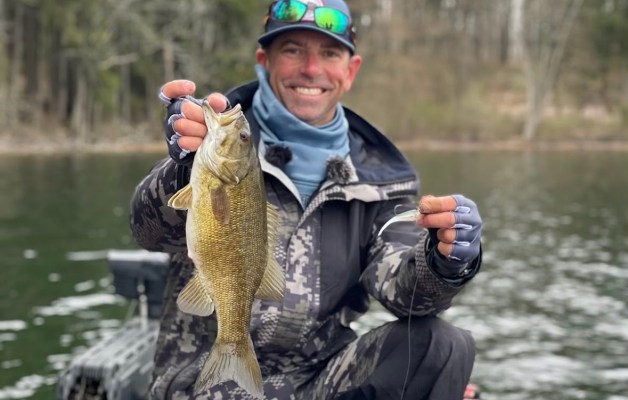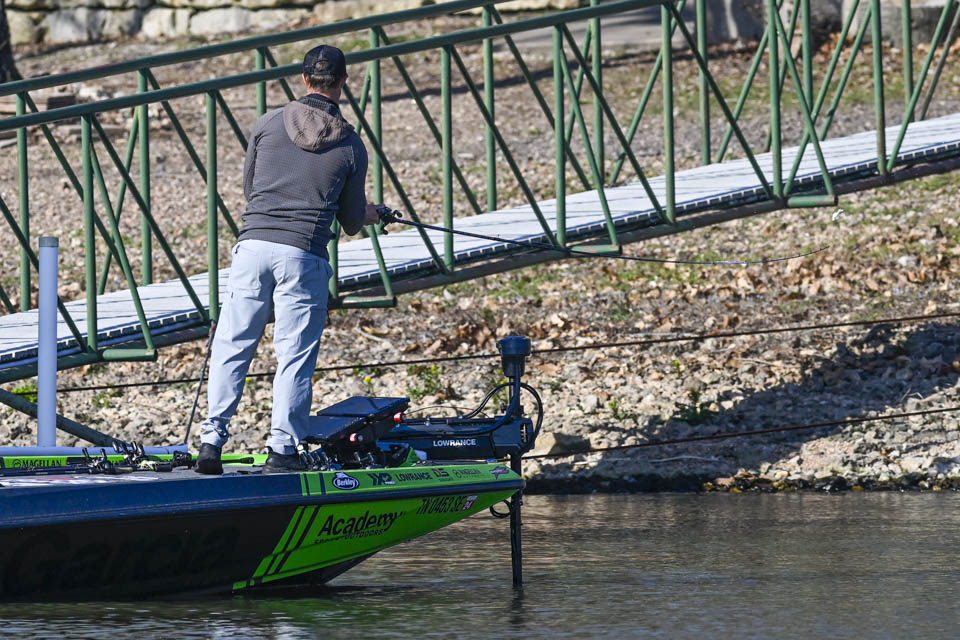
Depending on what part of the country you are fishing, bass could be in any or every phase of the spawn right now. Elite pros break down each
While April may show a dwindling influence of spring’s temperamental tendencies, bass have spawning on their minds. Some are on their way up; some will be headed out; and, depending on the fishery, others will be sitting on those cleared-out hard spots. Four Bassmaster Elite Series pros offer their insight on how they find April big ’uns.
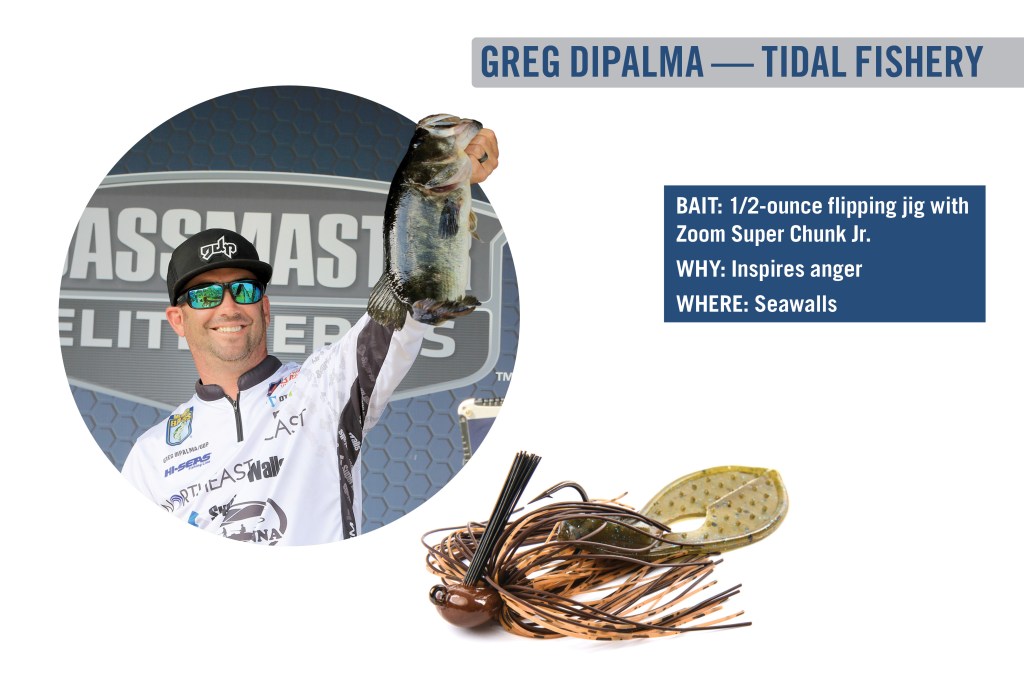
GREG DIPALMA — TIDAL FISHERY
Prior to his Elite Series career, Greg DiPalma spent a lot of time guiding the Upper Chesapeake Bay area, where he got a good look at seasonal dynamics. One of his most profound discoveries involved a preview of coming attractions — specifically, the very tip of the spawning spear.
“Typically, during April in the Upper Bay, I target super-early spawning bass and I can usually catch four or five a day,” DiPalma said. “When I’m targeting these fish, nobody’s even thinking about it. Usually, the first or second week of May is when most people start looking for spawners.
“Typically, they’re giant [Northern largemouth] because they’re the first wave of big spawners to come up.”
How big is big? DiPalma said he expects to find fish in the 5- to 7-pound range, with the occasional 8- to 9-pounder. The scenario’s very specific, but when it’s on, it’s practically a guaranteed tank.
“That first wave is not a giant wave; it’s a select few, but there are usually giants,” DiPalma said. “That time of year, weather is a factor because it’s early in the season where you have a lot of ups and downs.
“Those really big fish will snuggle their way back into the really deep marinas, where they’ll spawn in 6 to 8 feet on the back seawalls. These are the most protected areas in the marinas.”
True to bass nature, these early fish will set up shop over clean, solid bottom. Knowing where to find this scenario comes down to considering marina construction.
“Sandy bottom is the big key,” DiPalma said. “Those back walls are dredged out, so a lot of them have sand mounds from where they ran the pilings down for the bulkhead. It’s premier spawning area. I know they’re spawning because they have bloody tails.”
As DiPalma notes, full moons crack the whip on this early wave’s movement, and when a warming trend aligns with this lunar phase, it’s game on. Also, unlike the more sensitive Florida-strain bass present in the bay’s lower reaches, DiPalma has found Northerns making that marina trip in surprisingly chilly water.
“For Northern-strain bass, time of day is not as important because they just don’t seem to care,” he said. “The coldest I ever caught one off a bed was [a 6.67-pounder] when the water temperature was 42 degrees, but when that water hits the low 50s, it really starts happening.”
One of the biggest marina benefits DiPalma has found: water stability. With Upper Bay tidal influence less pronounced than in the lower end’s Atlantic proximity, those early spawners don’t have to worry about significant flushing.
“The water doesn’t go in and out; it just goes up and down,” DiPalma said.
A bold presentation with a 7/16- to 1/2-ounce flipping jig (green pumpkin or black/blue for dirty water) with a Zoom Super Chunk Jr. offers the large, intrusive profile that redlines a spawner’s aggression. If he needs a lighter touch to close the deal, DiPalma throws a drop shot with a 6-inch Roboworm Texas-rigged on a 4/0 Hayabusa hook and a 1/4-ounce weight.
With either bait, presentation is key, as these big spawners hug that seawall. Stealth always matters — even with deep spawners — but DiPalma knows the importance of a targeted cast.
“Obviously, you don’t want to be crazy loud, but you want to hit that back wall and make your bait fall right down that [edge], because the beds are literally right at the base of the seawall,” DiPalma said. “There’s a sand shelf that only comes out a foot or two, and those fish are spawning just about against the wall.
“I think it’s super-important to get your bait against that wall. As soon as you slide it down, they got it. A tight cast is the key.”
BAIT: 1/2-ounce flipping jig with Zoom Super Chunk Jr.
WHY: Inspires anger
WHERE: Seawalls
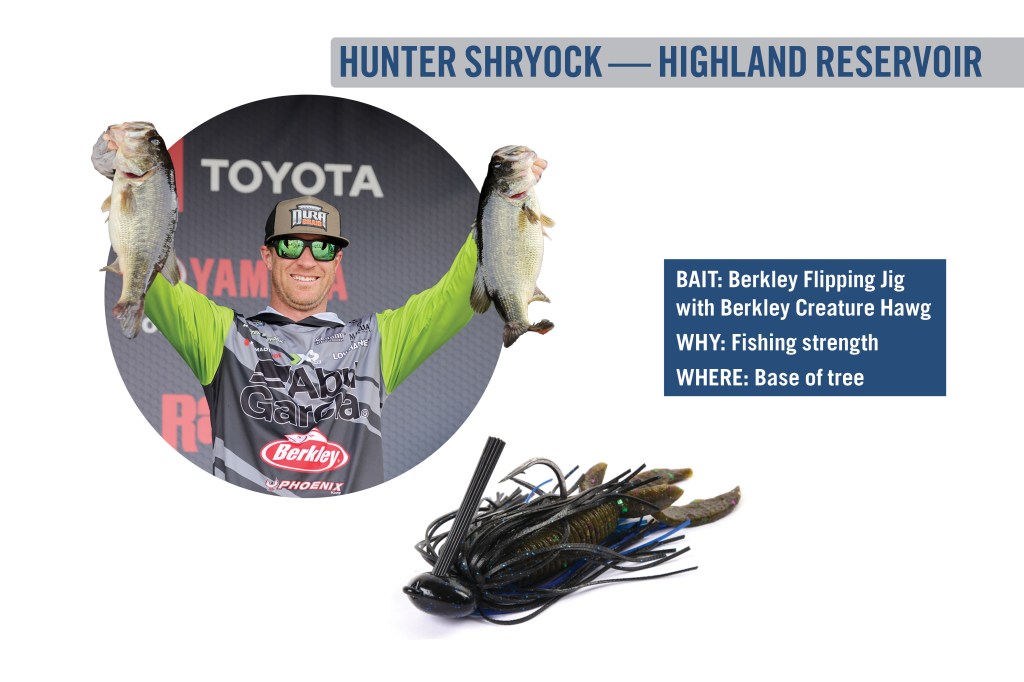
HUNTER SHRYOCK — HIGHLAND RESERVOIR
Laying down a refreshing dose of transparency, Hunter Shryock bypassed the temptation to suggest a big glidebait for the highland reservoir’s typically clear-water scenario. That’s not for any lack of trust in this proven giant tempter — rather for a strong adherence to an immutable angling truth: Fish your strengths and you’ll fish more effectively, especially where giants live.
“We tournament anglers get wrapped up in trying to get a bigger bite by doing things that we’re not comfortable doing,” Shryock said. “I’m comfortable fishing shallow, and in April, there’s a ton of big fish that are going to be shallow, so I’m going to roll with the thing that I have the most confidence with, and that’s flipping heavy cover.
“On a highland reservoir, there will still be [laydown] trees in the water on bluff banks and flats. I think the bigger fish tend to live a little deeper, or thicker.”
Appropriately, Shryock wants a beefy bait to invade where the big ones are likely to be sitting, so he flips a 1/2-ounce Berkley Flipping Jig with a Berkley Creature Hawg trailer. His thought: Whether they’re coming or going on their spring migration, the fish see a lot of modest baits hopping in and around their fortress. Flipping a bold profile into their personal space is a good way to make one go.
Most of the time, Shryock’s using black and blue, as he’s come to regard this as a consistent big-fish attractor. Putting that bait in the heavy-cover spots starts with targeting the ones closer to spawning areas, but looking deeper, Shryock explained his presentation particulars.
“I’m trying to get into the thickest part of that cover — basically where no one’s putting their bait,” he said. “Approaching it, I’ll work the outside with a pitch or two, but you don’t want to wait too late, because you’re running out of opportunities to present that bait into the heart of the tree.
“If it’s a good tree and I know the cast I need to make, I’ll want to make that cast first because I don’t want to risk snagging or disrupting the tree on the outside. You can get bit all the way around a tree, but more times than not, it’s right around the base or the center of the tree where the [giants] will sit.”
Lastly, Shryock warns against a hasty tempo. His advice: “We tend to get in a hurry and, before you know it, you’re getting pushed into a tree,” Shryock said. “Sometimes, you have to slow down to be more efficient.”
BAIT: Berkley Flipping Jig with Berkley Creature Hawg
WHY: Fishing strength
WHERE: Base of tree
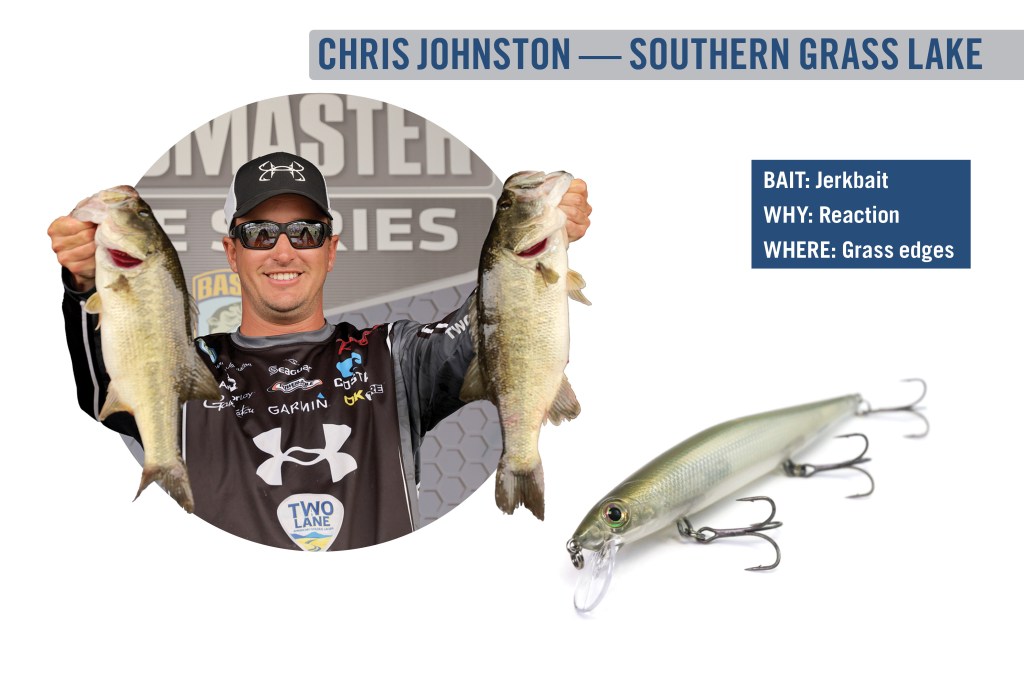
CHRIS JOHNSTON — SOUTHERN GRASS LAKE
Noting that the deeper grass lining spring migration routes offers a straightforward option for resting postspawners, as well as late spawners on their way in, Chris Johnston said a big part of his April mindset involves weeding out the time-wasters. A vibrating jig or a lipless bait will garner plenty of attention, but the Canadian standout employs a two-part strategy to locate those legit giants.
First, Johnston wants to find something that stands out as a strategic area for a big fish to park. Could a small fish find such a sweet spot? Sure, but when a big, experienced female says, “So, I’m gonna need this,” there’s rarely much resistance.
“You’re looking for [distinct] differences in the grass, whether it’s hard spots in the grass, a point or a bend; you just have to find where those bigger fish are grouped up,” Johnston said. “If you’re catching smaller fish, it’s not that you necessarily need to throw a different bait, but you probably need to be in a different area.
“There might be 2- to 3-pounders in one area and then 300 yards farther, there’s a little pod of big ones. Usually when you find those big ones, it’s an irregularity in the grass. The key is finding those subtle differences.”
The second half of Johnston’s plan keeps him on the same migration routes, only with a broadened search. Specifically, while he’s scanning and fishing the grass edges, he’s also keeping an eye on the deeper water just off the drop. This is where he’s most likely to find the super-heavyweights suspending in pleasant solitude.
“You can find these fish on forward-facing sonar while you’re fishing the grassline,” Johnston said. “These are the fish that don’t get pressured as much. I usually find those big ones individually; they’re more random, but when I find them that way, they’re usually the giants.”
Clarity and depth typically determine what Johnston throws at those fish holding off the edge, but a jerkbait or a jighead minnow are good bets.
“If you have clear water, that’s when you throw a jerkbait to try and get them to react,” Johnston said. “If they’re deeper, you can use that jighead minnow with forward-facing sonar or a spybait.
“Some days you can throw a jerkbait at them and they’ll come and eat it right away, but some days they can be stubborn. You might throw at 10 and you won’t get a bite, and then one will decide to eat. It all depends on the day.”
BAIT: Jerkbait
WHY: Reaction
WHERE: Grass edges
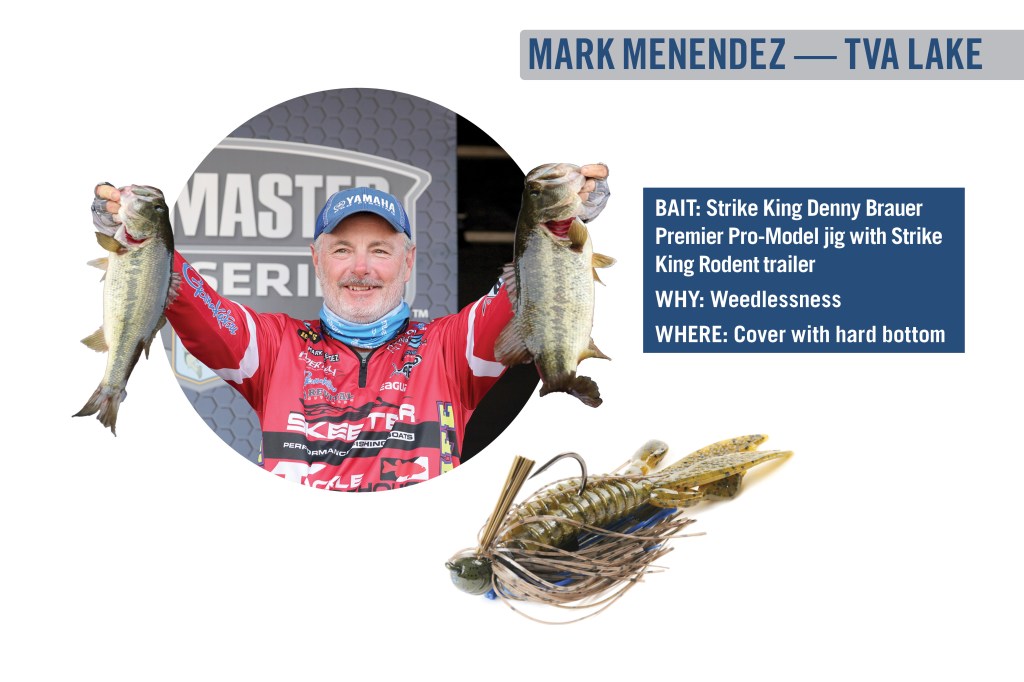
MARK MENENDEZ — TVA LAKE
Given the fact that each of the Tennessee River lakes has a specific schedule for winter pool drawdown and then the rise to summer pool, Elite veteran Mark Menendez knows you have to consider the calendar. That being said, he’s developed a game plan for targeting the true day-makers.
“It all depends on the elevation of the lake, but if we’re fishing before the water comes up, you’re in an absolute late, late-winter situation,” Menendez said. “Your males may run on up there with a little bit of rise in the water and a little water temperature rise, but your truly big females are going to be very patient, and they’re going to be behind you if you’re fishing the bank.”
To avoid such overshooting, Menendez positions in front of the spawning areas — flats with buckbrush and willow trees — and looks for the first contour change associated with an old creek exiting a bay. He’s looking for the most prominent change he can find, but Menendez considers the impact of time and current on aging reservoirs.
“Our lakes are old on the Tennessee River chain, so it’s really more of a depression than a true drop, most of the time,” Menendez said. “That may only be from 2 feet of water to 3 feet of water.”
Menendez will be looking for hard bottom or a piece of hard cover along these soft breaks. That could be a patch of gravel, a stump or isolated rock. Menendez isn’t picky, but he knows that finding a multilevel sweet spot raises his chances of hooking the one he came for.
“Sometimes, I can find some gravel back in those areas where the creek has washed out over the years, but if there’s gravel and a piece of cover, that’s a chance of catching a big fish,” he said. “I liken it to me being a nonsmoker in a room full of smokers — I don’t want to be in that.
“A bass really doesn’t want to be in that detritus-filled, coffee-colored water that can get stirred up easily. They don’t want to be in that environment, so they seek those areas with hard bottom so they don’t have to be in that smoke-filled room.”
With a giants-only mindset, Menendez fishes the staging spots with a 1/4-ounce Strike King Denny Brauer Premier Pro-Model jig with a Strike King Rodent trailer. Fishing this bait on 20-pound fluorocarbon provides plenty of strength for making a tantalizing presentation through any cover without extraction concerns.
“I can get that lightweight jig in that shallow water to come through that cover really well,” Menendez said. “I’m not swimming it; I’m getting it into the condominium and I’m rattling it and shaking it. I’m keeping it in close contact to that piece of cover, so that fish can find it.
“If you can find [several] of these scenarios, you can rotate through them three or four times a day,” Menendez said. “As one moves up, you pluck him, put him in the livewell and move to the next one. On your next rotation, you may have another bite.”
BAIT: Strike King Denny Brauer Premier Pro-Model jig with Strike King Rodent trailer
WHY: Weedlessness
WHERE: Cover with hard bottom




